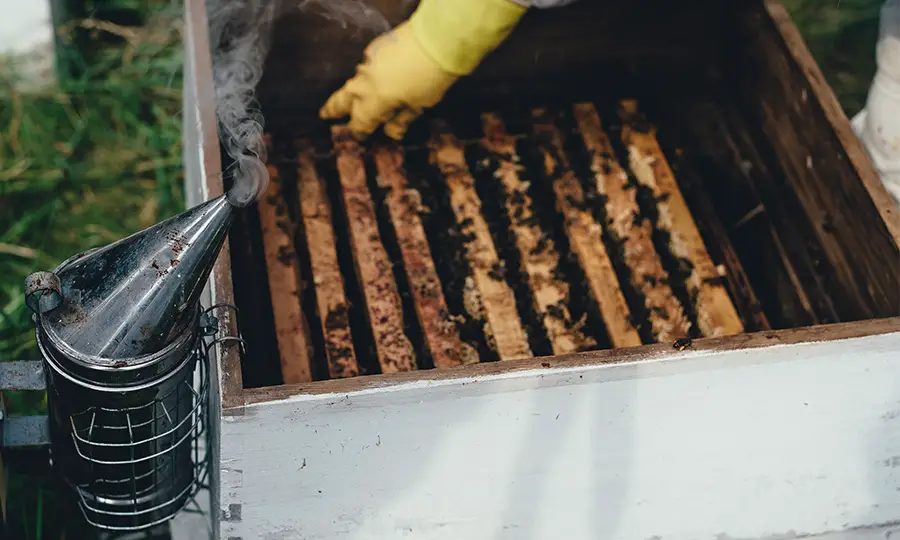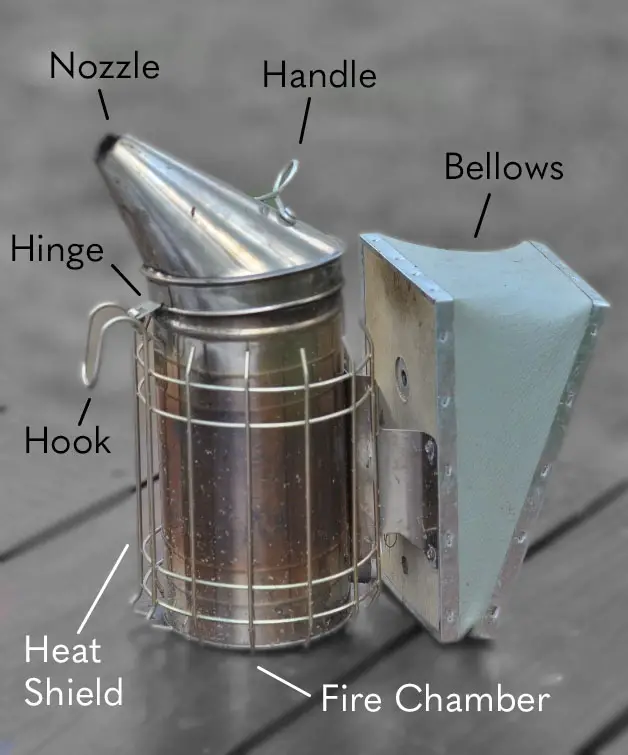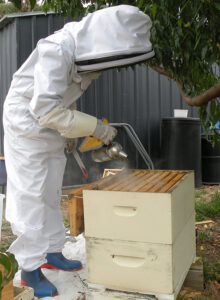You may have seen videos or pictures of beekeepers using smoke when they inspect a beehive. Maybe you’ve even witnessed it firsthand. This comes from a smoker – a steel cylinder that contains smoldering material that emits a cool, white smoke. A smoker is one of the most important tools of a beekeeper, as they use it to pump smoke into the hive immediately before, and during, an inspection. Why is this important?
Beekeepers use smoke because it calms the bees and allows the beekeeper to inspect the hive more easily without being stung. Not a lot of smoke is needed, and the interruption that’s caused by the smoke is temporary, allowing the bees to recover within 30 minutes. This enables beekeepers to inspect the hive without harming bees unnecessarily.

What Does Smoke Do To Honey Bees?
Although bees are typically friendly, they do become defensive during a hive inspection because they have brood (babies), a queen, and honey inside. That’s why bees are very protective of their hive and will quickly defend it if they perceive danger.
To alert other bees of the threat, bees secrete a chemical substance from glands on their bodies. This chemical substance is also known as alarm pheromone as it stimulates an alarm response in other bees.
Upon detecting the alarm pheromone, other bees will become aware that the hive is under attack and they will do two things:
- They will emit more of the alarm pheromone to alert other bees.
- They will defend the hive against the attacker, usually by stinging. As more and more bees emit the alarm pheromones, a greater defense will mobilize against the predator.
Do beekeepers use smoke to hide their smell?
More than hiding the smell of beekeepers, smoke dulls bees’ sense of smell, reducing their ability to detect alarm pheromones from other bees. This will calm bees down as they no longer think the hive is being attacked, making them less likely to sting you as a result.
Bees also release alarm pheromones when they get injured calling reinforcements to their location. That means that, if a bee stings you, other bees will become alert and may try to sting you as well. However, a few puffs of cool smoke will calm the agitated bees and allow you to proceed with the inspection more comfortably. That’s why smoke is an excellent tool to prevent bees from attacking you when inspecting a hive!
Smoke Sends Bees into Survival Mode
Besides subduing the defensive alarms of honey bees, the smoke has another effect. When bees smell smoke, they associate it with fire. Their immediate reaction is to begin gorging themselves on the available honey from the hive.
The reason bees do this is that they perceive the hive is being threatened by fire, and they need to look for a new home away from the danger. If they do leave the hive, the bees will build a new one in another location. To do so, they need a lot of honey. This is why they begin gorging themselves when they sense smoke.
When bees become engorged with honey, they are usually more docile and less likely to sting as a result. A word of caution, though – use smoke in moderation. In small amounts, smoke will not harm bees. However, using too much of it will cause larger numbers of bees to eat up honey and leave the hive for good.
What Is A Bee Smoker?
A smoker is an essential piece of equipment for the beekeeper. Smokers are made of hard-wearing stainless steel, with bellows to depress to get the fuel burning and to keep it going.
Smokers vary in size from small to large with a lid and a spout. They have a grill inside the cylinder which helps distribute air and stops the fuel from burning through the base of the smoker. Your smoker should have a metal cage around it so that you won’t burn your hand on the hot cylinder.

My initial purchase was a small smoker, which I thought would be sufficiently large enough for me as I just had one hive to attend to at the time. As a new beekeeper, I was hesitant and a bit slow with my inspections, and I soon discovered that occasionally the smoker would go out before I had finished.
I was so absorbed in what I was doing that I often forgot to keep depressing the bellows. As a result, I would end up having to either cease the inspection quickly or try to get the smoker going again by furiously pumping the bellows.
Therefore, for the novice beekeeper with one or two hives, I recommend using a medium-sized smoker because of its convenience. It’s not too heavy to hold and can stay alight for longer. This allows you to conduct your inspection thoroughly without worrying about the smoker going out, and you can inspect more than one hive.
Naturally, as you gain more experience and confidence, you will be able to inspect the hive more efficiently and thus disturb the bees less.

how to use A Smoker
I always ensure I put plenty of fuel in the smoker to keep it going for a reasonable amount of time, and I take the bag of fuel with me to the hive, so I have it at hand should the smoker need to be topped up.
To fuel the smoker initially I insert some shredded or torn newspaper into the cylinder and set alight. I use long-stemmed matches, but a barbecue lighter is also a good idea. It has a long metal end that can be pushed into the fuel inside the cylinder, therefore more successfully keeping the smoker alight.
When lighting your smoker, keep the lid open and gently squeeze the bellows to stimulate the flame. Once alight, extra fuel can be added. This can be pine needles, dry gum leaves, old hessian sacking, paperback, or cardboard.
What to use as fuel
My preference is pine needles as I have access to plenty of them, but you can use whatever you have at hand. Just experiment to see what works best for you and what will produce the cool white smoke needed.
When using smoke on your hive, remember that you don’t need a lot. Only use a few puffs at the entrance, as well as an occasional puff during the inspection.
Other Methods Used To Smoke Honey Bees
Essential oils such as lemongrass, spearmint, and peppermint oil can be added to the smoker too. The addition of these oils is meant to enhance the effectiveness of the smoke and further depress the alarm pheromones in bees. Essential oils also have some antibacterial and antifungal properties that some people believe are beneficial to the hive.
I have never tried essential oils, so I can’t comment on their effectiveness. However, it is certainly worth considering and something for you to decide personally. Check with an experienced beekeeper to find out what they use and ask for any recommendations.
Do All Beekeepers Use Smoke?
Some beekeepers prefer not to use smoke when inspecting a hive. There are numerous reasons for this, and they depend on the beekeeper. Some prefer a completely natural style of beekeeping. Others believe it will affect the taste of their honey.
These beekeepers instead open their hives without smoking the bees. They take great care not to accidentally kill any bees (so as not to set off the alarm pheromone).
While it is certainly possible to inspect a hive without smoke, I prefer not to do so. Most beekeepers who do inspect a hive without smoke tend to be highly experienced, and understand the best times of day to open their hive and how to do so without disturbing their bees.
If you are a novice beekeeper, I suggest using smoke. It has proven to be an effective method of calming bees over many years and will help you get used to inspecting your hive.
Conclusion
Beekeepers use smoke to calm bees. This is done to make it easier to inspect the hive without getting stung. While it is not absolutely necessary to use smoke when inspecting a hive, I believe it is a good idea, especially for beginners.
